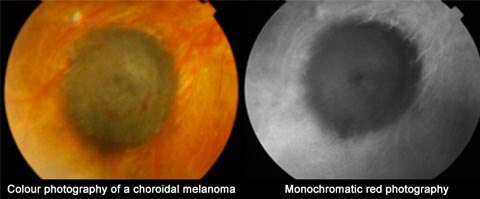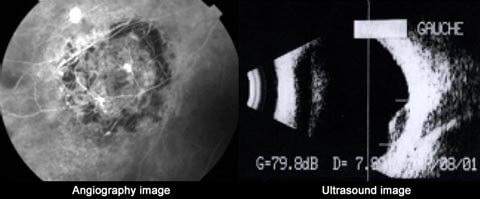Eye tumours
Description:
The melanoma is diagnosed with a fundus examination.
Symptoms:
The tumour can be absolutely asymptomatic or responsible for various visual disorders:- Flashes
- Floaters
- Reduction of the visual field
- A fall in visual acuity
Uveal melanomas look like a tumour in relief, most often with a pigmented appearance.
Further examinations of various sorts (mostly angiography and ultrasonography) will confirm the diagnosis and help choosing the best treatment.
Treatment:
Treatment is variable depending on the melanoma’s localisation and size:For small and medium-sized lesions, we will use conservative therapy (proton therapy, curietherapy and/or exceptionally localised exeresis surgery). However, enucleation remains necessary for major lesions.
Post-surgical evolution:
After radiotherapy (proton therapy or radioactive plaque) of voluminous tumours, some complications might arise, in particular ocular exudation or hypertonia.After exeresis surgery, the eventual complications arise sooner and comprise intravitreous haemorrhage or retinal detachment.
A long and rigorous medical follow-up will be necessary, with general (hepatic ultrasonography) and ophthalmological examinations every 6 months.
Even with a satisfying response to the eye tumour, we observe the development of metastasis in a small number of cases. We can then proceed to chromosomal analysis of the tumour, through a genomic study after transscleral puncture or transvitreal biopsy using 27G TDC cutter.
Most frequently observed anomalies are monosomy3 and multiplication of 8 at the level of tumour cells.
There is a correlation between these anomalies and the patient’s vital prognosis.
New research is being done to identify other molecular markers more specific to a high relapse risk. These molecular signatures could also serve as targets for new therapies.

 Book an appointment
Book an appointment


